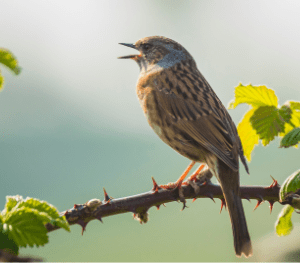By Christiane Goaziou
The Chiff Chaffs have arrived, re-joining the odd permanent resident. It has been raining in abundance , but Winter has ceded its place to Spring, and we have already had sunny skies and warmth. The wild garlic has been flourishing in Westridge woods and the bluebells are adding their colour and sweet scent to it. Wherever you look, you can see violets, primroses, celandines, and the trees are showing their fragile, green foliage.
Swifts, swallows, house martins are arriving , hopefully in good numbers and cuckoos, nightjars, ospreys and more will be with us at least until October and give us joy.
But I digress…
Today I want to talk about the Dunnock, an underdog in the small birds world, which is everywhere and which few people notice; an inconspicuous, unassuming, slightly nervous little bird, the size of a Robin without its ‘Do you know who I am posture
The Dunnock is a brown and grey bird with a striped brown back, a dark grey head , a lighter grey breast and a black , short, thin bill. It is around 24 cm long with a wingspan of around 19 to 21 cm and a weight of around 25 grams. Its lifespan is of 2 years on average.
The dunnock feeds on insects, seeds, worms, and spiders , mainly on the ground; it nests usually in hedges but sings a short high pitched song, repeated every minute or so from a well exposed perch.
The Dunnock is a very common bird which can be seen everywhere, in the country or in town, in woodland, farmland, parks and gardens yet, sadly, rarely noticed.
The dunnock is often referred to as the ‘hedge Sparrow probably because its favourite area is hedges but it is not a sparrow at all, and, although he slightly resembles a female house sparrow, its family is the Accentors and he is the only type of Accentors in the UK. Sparrows are noisy, gregarious ,boisterous, funny hooligans of the small birds world while the Dunnock is quiet and shy and seen in no more than pairs .Yet, when 2 males meet , the Dunnocks show their other side and get territorial and very aggressive and feathers fly, particularly in the mating season.
As for the female Dunnock, she can be a little naughty in the mating season but for a clever reason. Although she always mates with her usual other half, she will also mate with another male and, as neither male will know who the father is, both males will feed the chicks.
They nest close to the ground, in shrubs.
 If you see a flock of house sparrow feeding, check to see if a Dunnock is nearby. Dunnocks dont feed from feeders, but they can be seen under the feeders or even, sometimes, under the bird table.
If you see a flock of house sparrow feeding, check to see if a Dunnock is nearby. Dunnocks dont feed from feeders, but they can be seen under the feeders or even, sometimes, under the bird table.
So, look closely when birds are gathered eating in your garden and if you spot a small brown and grey bird on the ground , minding its own business, look closer, it might be a Dunnock.

